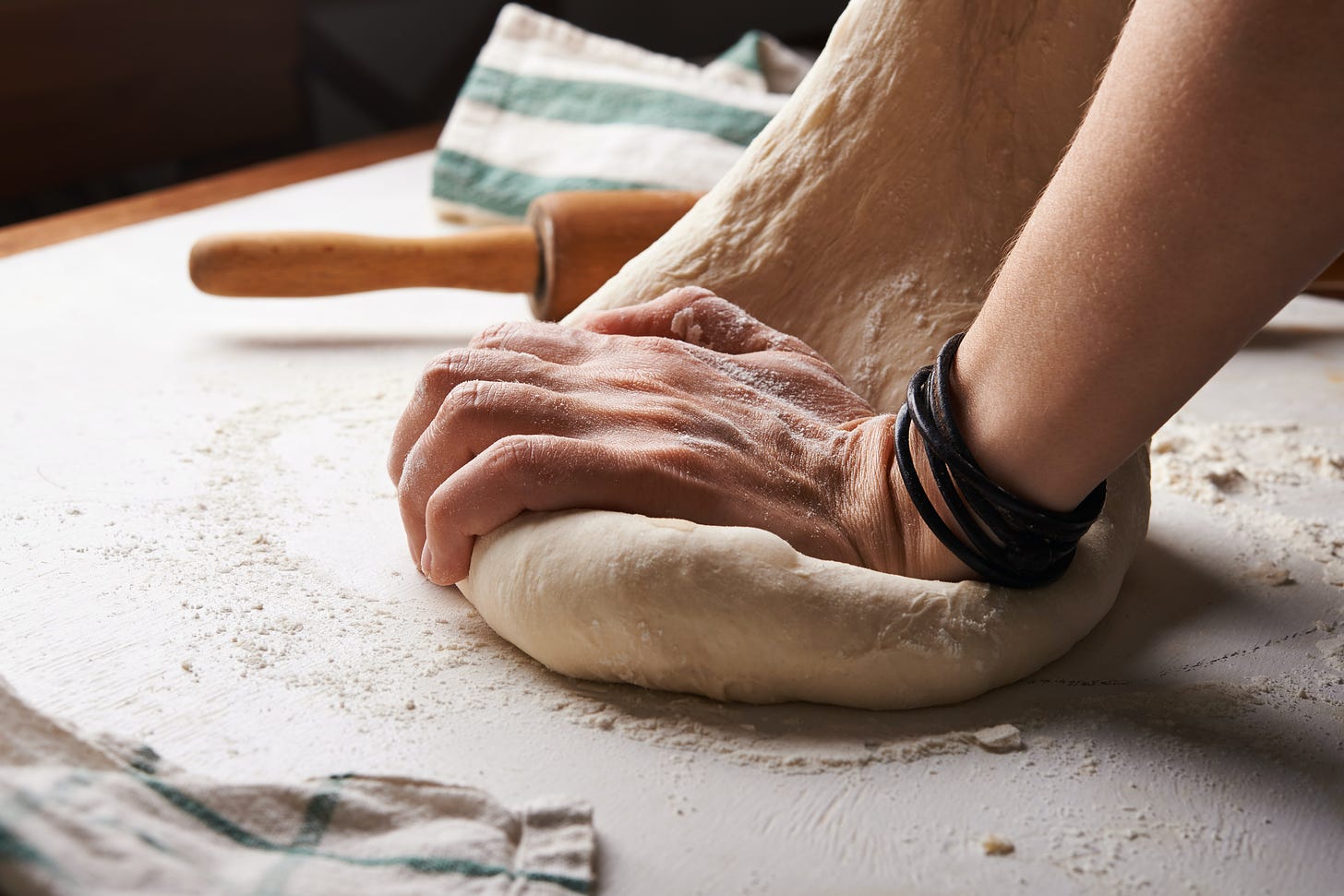Hi writer friend,
Today’s issue is an essay from guest writer, Lynne Curry. I tried Lynne’s method of mixing bread baking and writing the other day, and this might be my new favorite way to get work done. So, enjoy! If you’re a paid subscriber, I’ll be back in your inbox tomorrow with the usual big list of writing opportunities, including pitch calls, fellowship and grant deadlines, random inspiration, and lots more. Also, later this week, I’ll be sharing the pitch that landed me this assignment for Outside Magazine.
Britany
When I started freelance food writing in Seattle over 20 years ago, I worked four days a week in fine dining as a cook and baker. I adored my kitchen crew, the top-notch ingredients and Northwest wines. But the best part? From morning prep until 2 am mop, my hands were busy and my mind on autopilot.
By the time I hit my desk on Monday, I was 100% mentally recharged.
Those labors provided the perfect right brain-left brain formula for the writing life. But I didn’t see this until I became a full-time freelancer. After my husband and I moved to a tiny Oregon town, I had all the time in the world for ideating and pitching, researching and writing. But my time management skills were nil.
Fast forward years later. Like many writers at every experience level, I struggle with resistance by the metric ton. It doesn’t matter if it’s a brief story on a tight deadline, a long-form reported piece or a blog post. Like a serial dieter seeking a magic pill, I have searched for the perfect productivity tool.
I settled on the pomodoro timer. But it turns out, I had a better method long before.
Last winter, the grip of the pandemic kicked my bread baking back into high gear. I’m an on-again, off-again home baker, but I studied professional baking in France, researched and recipe tested a cookbook for a NYC baker and teach sourdough baking classes. So, I’m versed in the techniques and commitment involved.
One day in February when I combined a writing assignment with a bread project, it was like toast meeting butter: completion! Baking bread organized my day, compressed time and calmed my monkey brain.
Why Bread Baking is Better Than a Tomato Timer

There are a lot of reasons why baking bread is a viable productivity tool. It involves a series of steps punctuated by short breaks with periods for focused work. It also requires working with your hands, activating the right brain and shifting attention away from word churning. (I mean crafting.)
Unlike other household tasks—say, gardening or house cleaning—baking bread also has a clear beginning, middle and end—with a tangible reward. (More on that later.)
According to psychologists, the baking process induces a sense of calm and may even promote creativity. For me, there is a deep benefit from periodically getting back into my body to focus on a manual task. When good writing often feels like an unguided trip into deep space, especially the early stages, the feeling of dough in my hands is grounding.
A writing day is like a journey filled with possibilities. But without a road map, it’s easy to squander the time. Next time you’re planning a writing project—personal or deadline-driven—try this time management strategy. Even if you’ve never baked bread, I propose the following method for pairing a writing project with baking a homemade loaf.
7 Steps to Bread: An Outline for Writing
I originally learned to bake bread from The Tassajara Bread Book. First published in 1970, it was written by Edward Espe Brown at the famed California retreat center. I’ve modeled this outline on the book’s beautiful accessibility and adaptability to your own resources and proclivities.
Bear in mind, there are a million ways to make really good bread. Choose any recipe you like, such as one you already use, or from a classic bread cookbook or reputable Internet source.
The specifics are unimportant, or as Brown writes, “Recipes are only a guide...to be fleshed out according to your nature and desire...Actualize breadmaking itself.”
Preparation. Gather your ingredients and tools and plan out the recipe timeline. If you’re using a sourdough, refresh it, or if the recipe calls for a starter with commercial yeast, mix it up as directed. Both types of pre-ferments kick-start the yeast and bacteria activity that produces the most tasty and lofty breads.
Same with writing. Consider your project goals and organize your writing space.
Mixing. Mix the dough as directed. Using your hands offers a full-body experience. Even if the recipe doesn’t mention this, leave out the salt for now. Allow at least 20 minutes for the starches to fully absorb the water and swell, the way ideas gestate during sleep.
Now is a good time to boot up your computer and, if you must, peek at your email. Then, add the salt, using your hands to squeeze the dough until it becomes cohesive. (Your recipe may call for active kneading, but most contemporary bread recipes are no-knead, relying on a quicker folding method to develop the gluten.)
First rise. The next two hours or so is the most critical stage for bread and your go time. About every 30 minutes, get up if you’re instructed to fold the dough. Notice how it becomes less resistant, more relaxed. If not, take a two-minute break to observe the dough as it grows pillowy. This natural fermentation process develops structure and complex flavors over time. How can you apply this principle to your work?
Shaping. A long break from your writing! Prod the dough from the bowl with your hands and divide it as directed. Some recipes suggest a rest before the final shaping. Take this opportunity to do something rejuvenating like a quick walk. Then, shape the dough in preparation for its final rise.
Proofing. The next 90 minutes (or more) is the climax of fermentation. Provide the dough with a cozy environment, such as under a large bowl, on top of the refrigerator or in a beam of sunlight.
Once your timer is going, get back to work and remember to nurture yourself—as you did the dough—during this dedicated writing stretch. Get out of your chair every 30 minutes and check on the dough’s progress.
Baking. Give yourself over to the baking stage with all of your senses. You can watch the wonders of starches gelatinizing, sugars caramelizing and proteins roasting through the oven window. Or take another long break until the bread is gorgeously browned.
Cooling. Allow at least one hour for the loaf to steam and finish baking or it will be soggy inside. Meanwhile, wrap up your writing session: revisit your outline, note where to pick up next time or make a pass at revisions. Then, put it away.
Now, there is only crusty warm bread to eat, perhaps with a bowl of soup. Sure, your loaf may be flawed in shape or crumb structure. “This could be better,” you think. But consider the metamorphosis you’ve produced from ordinary elements into this singular existence.
And so, like all things of this nature, it is bound to be imperfect. But at the same time, and in spite of it all, doesn’t it taste pretty great?
A former farm-to-table restaurant owner, Lynne Curry writes about food and farming with a focus on the environment, animal welfare and small-scale agriculture. Her food essays have appeared in Tin House, Eating Well and Leite’s Culinaria. She has written articles with recipes for Food52, Fine Cooking, the Los Angeles Times, the Washington Post, the Oregonian, among many others, and posts regularly on her mindful cooking blog, Forage.






This was fabulous!